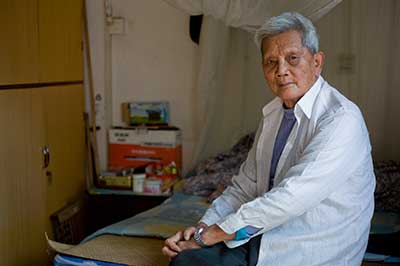


|
Juliang Tang was born in 1932, in the Nanhai District of Foshan. He lives in the Hongwei leprosy village in Nanhai, Foshan, where he has lived for the past 60 years. He started to study painting and calligraphy on a self-taught basis in 2006. He has a passion for landscape painting, Gong-bi (fine-brush) painting and calligraphy. There is a wide range in his paintings. His calligraphy integrates with the Clerical Script (Lishu), Running Hand (Xingshu), Cursive Hand (Caoshu) art style and other traditional Chinese calligraphy styles. He is accomplished at playing the Er-hu musical instrument, Cantonese opera, chess and writing poems. --- Personal Experience: “I Express Myself Through Painting” At the age of 70, Juliang Tang started to study painting and calligraphy by imitating various pictures of plants and animals from painting books. His works of calligraphy not only integrate with Clerical Script (Lishu), Running Hand (Xingshu), Cursive Hand (Caoshu) art style and other traditional Chinese calligraphy styles, but also integrates with his own creation from his inspiration. Tang says that Mr. Zhiming Lin, who lives in the same leprosy village, often lends him books and painting albums so that he can imitate painting and calligraphy, which helps with the growth of his technical skills. Tiger, the painting he donated to HANDA is an example of one of his paintings that imitates an image from the painting albums. His works were exhibited in the Guangzhou Library, he was once invited to sell his paintings at auction and all received positive comments. Tang is proud that his paintings often received praise from university students when they visited the leprosy village. They are students from Guangzhou University of Chinese Medicine and Guangdong University of Finance and Economics. He has given over 100 art works to the university students whose encouragement and appreciation motivate him to create further outstanding works of painting and calligraphy. Due to the impaired flexibility in his hand, it is difficult for him to write small sized characters with an incisive style, he has to learn to write big characters. However, as the university students do not visit the village as often as before, Tang’s quantity of art works has gradually decreased. He has visited leprosy villages in Zengcheng, Huadu, Taihe, Mazhou, Gaoming, Sian and Yaxi etc to communicate with people who love painting and calligraphy there. He hopes to have more opportunities to communicate with people who love painting and calligraphy so they can learn from each other. For example, he feels that he is not good at choosing the right colour value to match light and shadow and Mr. Haiti Peng, an artist from Sian leprosy village, is proficient in that aspect. If there are more opportunities for people from different leprosy villages to share experiences and knowledge, they can improve their skill in art. In addition, people having the same hobby and interests can encourage each other and develop positive attitudes towards life through the opportunity to meet each other. Tang originally started to paint and write calligraphy simply to kill time and find spiritual sustenance. He doesn’t set any particular goals to achieve in his art. Probably his attitude in finding something just for self-entertainment is the most philosophical way to understand art. Apart from painting and calligraphy, Tang also writes poems. His poem which celebrated Dr. Yang Lihe’s 80th birthday was published in a HANDA newsletter. Tang says that he often recorded his dramatic life experience during his spare time. He has recorded his life experience and the 60 years history of Hongwei leprosy village. He has made this record of history into rhythms and composed them into songs of Cantonese opera. There is no doubt that these words are precious materials for the leprosy heritage history and oral story collection. Leprosy may vanish from the world within 30 years. However, the history of leprosy will never disappear. It will remain as an important reminder to future generations that there were people who suffered greatly but still kept a positive and creative attitude towards life. --- Source: HANDA Rehabilitation and Welfare Association, The Beauty of the Spirit, (Guangzhou, 2014) |